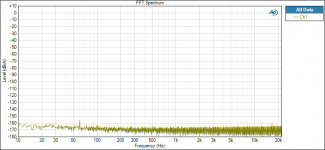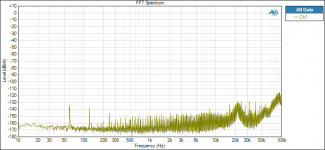I've just moved the discussion about using exaU2I with the Twisted Pear SPDIF Transceiver to a new thread: http://www.diyaudio.com/forums/exad...connected-twisted-pear-spdif-transceiver.html. This is a brand new application for exaU2I and it deserves its own space.
Last edited:
Just curious, with the EXAU2I, assuming the same software is used, does the PC matter any more? i.e. AMD vs Intel Cores vs Intel ATOM, slow vs fast CPU, quality of the USB port/cable/length etc?
Depend who you ask. Theoretically the PC etc. doesn't matter anymore. In my personal experience, if the CPU is fast enough to keep up with the data stream, and the PC power is within the industry standard norms, the sound is not affected by the computer hardware. I've seen situations when the USB power is below 4.4V, and I've seen USB controllers that are not doing their job. In general, an average PC is not affecting the sound quality. I've done blind tests of exaU2I, and so far I haven't met an audiophile that can reliably identify the sound of different computers or USB cables.
Many will disagree, and I respect their opinions. I am always interested to participate in listening tests, and to experience different ways of doing high-end audio.
Regards,
exa065
Ground isolation - with and without
Here are exaU2I /ES9018 DAC noise floor measurements with and without ground isolation. Both measurements are taken with the exaU2I USB cable connected to a standard PC: no special power supplies or filters, regular hard drive, I7 CPU, standard USB 2.0 controller. The exaU2I is powered by the USB cable. For the second measurement the USB ground is connected to the DVCC DAC ground with 1MOhm resistor.
You can clearly see the benefit of using Galvanic isolation. It is impossible to achieve this level of common noise suppression with USB and SATA filters, audiophile grade USB controllers, or by "cleaning" computer power lines.
Here are exaU2I /ES9018 DAC noise floor measurements with and without ground isolation. Both measurements are taken with the exaU2I USB cable connected to a standard PC: no special power supplies or filters, regular hard drive, I7 CPU, standard USB 2.0 controller. The exaU2I is powered by the USB cable. For the second measurement the USB ground is connected to the DVCC DAC ground with 1MOhm resistor.
You can clearly see the benefit of using Galvanic isolation. It is impossible to achieve this level of common noise suppression with USB and SATA filters, audiophile grade USB controllers, or by "cleaning" computer power lines.
Attachments
thanks George.
that's exactly what I want to hear. Getting an audiophile grade PC costs a fortune after I did some research. linear power supply, fanless cooling with Intel cores ... special USB cards ... silver SATA and USB cables ... no thanks. I thought the EXA is to eliminate all of those requirements.
But then, what's the minimum requirement on the CPU? Is an ATOM fast enough?
that's exactly what I want to hear. Getting an audiophile grade PC costs a fortune after I did some research. linear power supply, fanless cooling with Intel cores ... special USB cards ... silver SATA and USB cables ... no thanks. I thought the EXA is to eliminate all of those requirements.
But then, what's the minimum requirement on the CPU? Is an ATOM fast enough?
thanks George.
that's exactly what I want to hear. Getting an audiophile grade PC costs a fortune after I did some research. linear power supply, fanless cooling with Intel cores ... special USB cards ... silver SATA and USB cables ... no thanks. I thought the EXA is to eliminate all of those requirements.
But then, what's the minimum requirement on the CPU? Is an ATOM fast enough?
yes i'm pricing a PC ATM.. it can add up very fast depending on which specs you choose.
how much memory? sorry if you have mentioned this earlier.
Our ASIO drivers are very efficient. An Atom CPU can support 384kHz / 4 channels at about 40% load.
Atom CPU running Linux and 384kHz / 2 channels is about 1 - 2% load.
I do not want to think of what evils
 the 39% in difference are causing.
the 39% in difference are causing.So I am waiting for ALSA drivers to use the exaU2I with MPD
Last edited:
So I am waiting for ALSA drivers to use the exaU2I with MPD
Same for me...would be great to have puppy and mpd with you card and not the nasty sounding w7...this product is for the hardcore guys...any chance ?
and 40% of a core i5 load is enormus.. you need to add DSP and better drivers in that thing ... this is crazy stuff.. Your like 20 years late on pro audio soundcards... you gonna close the doors to only audiophile that use their computer for nothing else than audio... kinda crazy..
Forgot to mention the test was definitely not biased in Exa's favour: the WaveIO had a separate transformer and a Jung-type regulator and also used my favourite USB cable, whereas the Exa had to do with USB power. As for the cable, the silly mini-usb socket forced the use of a cellphone data cable
Could you please elaborate what are main differences between waveIO (by Lorien?) and EXA converters? Words like great, huge step up etc don mean that much
Words like great, huge step up etc don mean that much
Please let me have a list of approved words and i'll see what i can do.
Still haven't done an exhaustive subjective comparison between the two. Not sure if it's worth my time and effort. Once i get the FIFO board from Iancanada i'll see if the output of WaveIO can be improved sufficiently to be usable. Reverting back to it in it's current form is just too painful.
Sorry I didnt mean to offend you but nowadays all stuff is marked as great, fantastic without any details what makes it so special. If you mentioned WaveIO and found EXA much better i would be thankful for more details where is so big improvement. If you arent in mood to share with it thats fine.
Do you have XMOS based converter from Lucien?
Do you have XMOS based converter from Lucien?
and 40% of a core i5 load is enormus.. you need to add DSP and better drivers in that thing ... this is crazy stuff.. Your like 20 years late on pro audio soundcards... you gonna close the doors to only audiophile that use their computer for nothing else than audio... kinda crazy..
I think exa was talking about 384kHz / 4 channels at about 40% running on an Atom.
I think exa was talking about 384kHz / 4 channels at about 40% running on an Atom.
Yes, I was referring to CPU usage on $350 ATOM netbook. I don't have access to an ATOM computer, and I don't remember the exact setup - player, memory etc. Foobar has by default a hystogram visualization on the toolbar. It becomes a CPU killer at high sampling rates. It should be removed for the test.
Same for me...would be great to have puppy and mpd with you card and not the nasty sounding w7...this product is for the hardcore guys...any chance ?
I am also inpatient to play with Linux driver development. There are just so many hours in a day...
Could you please elaborate what are main differences between waveIO (by Lorien?) and EXA converters? Words like great, huge step up etc don mean that much[/IMG]
Wave IO is 24bit, exaU2I is 32 bit. The matters when DSP processing (including software volume control or oversampling) is applied by the player. It is also a major advantage on Mac, where Integer mode is a problem.
exaU2I can go twice as high when it comes to sampling rate (384kHz), and this creates opportunities for oversampling. It also makes it possible to play DXD studio masters files.
We have control over the drivers, and this gives exaU2I an unfair advantage.
In my opinion jitter is a major issue with XMOS. Here is a post by JarekC -TAS1020B-based Asynchronous USB to I2S/SPDIF converter 24bit/96kHz. According to Larry, an XMOS employee:
" any external clock is resampled to 400MHz If you tie I2S signals BCLK LRCLK and DATA to a low-jitter external clock on the XMOS device, this will introduce a jitter in the order of one to two 2.5ns (400MHz) cycles"
exaU2I is 50 times better when it comes to jitter. In general FPGA cores provide much more accurate timing than CPUs.
Regards,
exa065
- Home
- More Vendors...
- exaDevices
- exaU2I - Multi-Channel Asynchronous USB to I2S Interface

